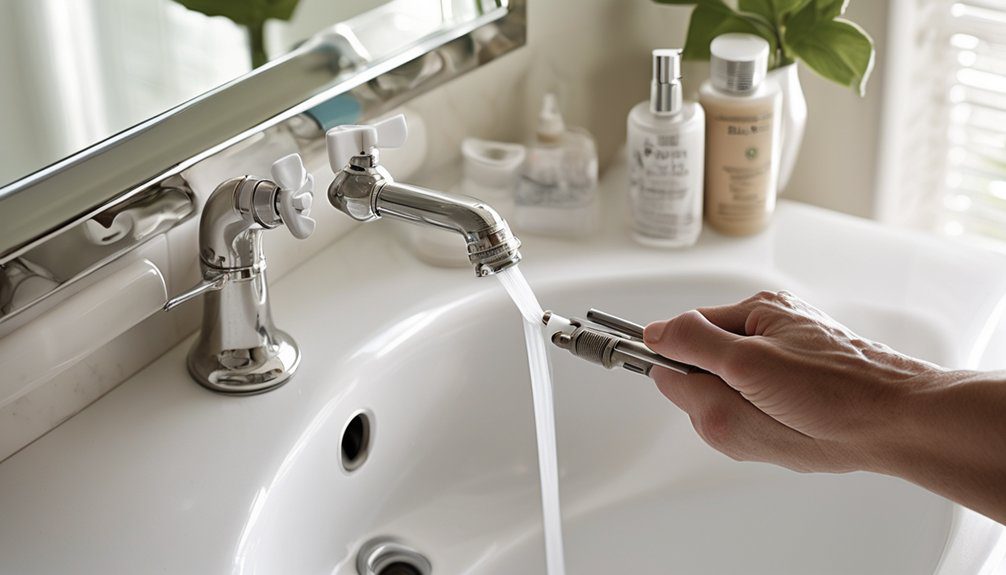To stop sewer gas smell in your bathroom in one afternoon, first locate the source, such as dry P-traps or faulty wax rings under the toilet. Add water to any dry traps and seal gaps around drains or toilet bases with plumber’s putty or caulk. Tighten loose plumbing connections and guarantee vents on the roof aren’t blocked. Finally, clean debris from drains and improve ventilation. These steps address common causes quickly, but if odor persists, further information on prevention and repair can help.
Identifying the Source of Sewer Gas Smell
Before you can effectively address the sewer gas smell in your bathroom, you need to identify its source.
Start by checking the drains, including the sink, shower, and toilet, for dry traps, which allow gas to escape.
Inspect the wax ring beneath the toilet for damage or leaks, as this seal prevents gas from entering your bathroom.
Look for cracks or loose fittings in the plumbing vents on your roof, which can also let sewer odors in.
Understanding where the gas originates helps you target the problem accurately, giving you control and freedom from persistent unpleasant smells.
Simple DIY Fixes to Eliminate Sewer Gas
Once you’ve pinpointed where the sewer gas is coming from, you can apply several straightforward fixes to stop the smell.
Start by checking the P-trap under your sink or shower; if it’s dry, pour water in to create a seal that blocks gas.
Tighten any loose plumbing connections to prevent leaks.
Use plumber’s putty or silicone caulk to seal gaps around the drain or toilet base.
If vents are clogged, clear them to allow proper airflow.
These simple DIY steps help restore your bathroom’s air quality, giving you freedom from unpleasant odors without professional help.
Preventative Measures to Keep Your Bathroom Fresh
Although occasional sewer gas issues can occur, you can substantially reduce their frequency by implementing consistent preventative measures.
Regularly check and maintain your bathroom’s plumbing traps to guarantee they hold water, as dry traps allow gases to escape. Keep drains clean and clear of debris, using natural enzymes or mild cleaners to prevent buildup.
Ventilation plays a key role; use exhaust fans or open windows to circulate air and reduce moisture. Avoid flushing non-degradable items that can clog pipes.
Frequently Asked Questions
Can Sewer Gas Cause Health Problems?
Yes, sewer gas can cause health problems like headaches, nausea, and dizziness. You shouldn’t ignore it—breathing it in repeatedly might harm your lungs or cause infections. Take action to protect your freedom and well-being.
When Should I Call a Professional Plumber?
You should call a professional plumber if the sewer gas smell persists despite your efforts, if you notice leaks, clogged vents, or damaged pipes. Don’t risk your health—let the experts handle stubborn or dangerous issues.
What Tools Do I Need for Sewer Gas Repairs?
You’ll need a plunger, pipe wrench, plumber’s snake, plumber’s putty, and a sealant gun. Gloves and a flashlight help, too. These tools let you tackle sewer gas issues confidently and reclaim your bathroom’s fresh vibe.
How Long Does It Take to Fix Sewer Gas Smell?
You can usually fix the sewer gas smell in just a few hours if you tackle the source directly. With the right tools and know-how, you won’t be stuck dealing with it for days.
Are Sewer Gas Smells Covered by Home Insurance?
Sewer gas smells usually aren’t covered by home insurance since they’re often seen as maintenance issues. You’ll want to fix the problem yourself quickly to avoid bigger damage and potential coverage denials down the line.






